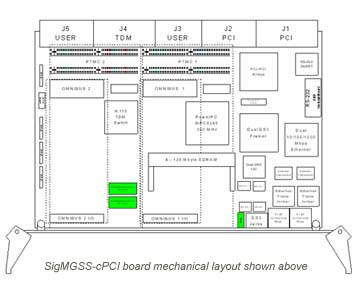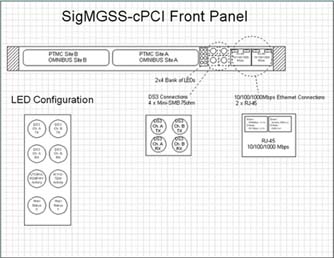SigMGSS-cPCI VoP Network / Telephony Carrier Board for Media Gateway and Soft-Switch ApplicationsNo Longer Available. Click Here For Recommended Solution
OverviewThe SigMGSS-cPCI board provides an IP-ready, high-connectivity, high channel density platform for media gateway, soft-switch, and other VoIP and VoATM infrastructure and carrier class products. Unlike less powerful boards with lower channel capacity, the SigMGSS-cPCI board does not attempt to force data processing through one or even more PowerPC or similar devices. Instead, the SigMGSS-cPCI routes data onboard via high-bandwidth Utopia and TDM busses, and uses the PowerPC for what it does well: host interface, command, control, and real-time operating system (in this case, Linux). The SigMGSS-cPCI board is particularly well suited for cPCI embedded telecom and Internet equipment OEM applications where space is at a premium, consuming only one (1) 6U form-factor slot. In a typical VoIP or VoATM application, the SigMGSS-cPCI board can flexibly route data under software control to/from DS3 and Ethernet streams to:
SigMGSS-cPCI Feature Summary
Specifications and Data Sheets Telogy Software ComplianceIf a SigC54xx-PTMC or SigC55xx-PTMC daughtercard is installed, then up to 1536 channels of 64 kbps PCM voice, fax, or data traffic can be processed using the SigMGSS-cPCI card (or up to 3072 channels if two PTMC cards are installed). For example, the SigC5441-PTMC card contains up to 32 (thirty-two) Texas Instruments C5441 devices, and is fully Telogy software compliant. Using Telogy software and onboard packet processing logic, SigC54xx-PTMC and SigC55xx-PTMC cards compress data via G.711 or LBR CODEC to produce packetized voice with RTP header, or fax data using T.38 protocol. For VoIP transmission, UDP/IP header processing is an option; for VoATM transmission compressed voice of fax can be sent using AAL0 / AAL1 / AAL2. 8245 Communications ControllerThe processor on the SigMGSS-cPCI board is a Motorola MPC8245 PowerQUICC® II device, with MPC603e core, 64 bit data and 32 bit address bus, running at 300 MHz. To the 8245 memory bus is connected a standard DIMM module that supports up to 4 to 128 Mbyte DRAM, and to the 8245 PortX bus is connected a boot/FLASH EEPROM device that provides up to 128 Mbyte of non-volatile storage. The 8245 incorporates an onchip a local PCI bus controller and an RS-232 DUART. One of the RS-232 channels is connected to a console port. A JTAG debug header is available for the 8245. Dual DS3 CapabilityThe SigMGSS-cPCI board contains dual, fully channelized DS3 spans, or 1344 total DS0 channels (TDM data). Using a routing PLD under software control, TDM data from the dual DS3 framer switched between the PTMC sites or local CT Bus (see H.110 Interface section below). The SigMGSS-cPCI board supports complete DS3 to DS0 de-multiplexing and vice-versa. In a typical system configuration, with a DSP resource card such as the SigC5441-PTMC installed, up to 1344 timeslots of TDM data are processed and packetized by DSP / voice codec devices. All four (4) Rx/Tx DS3 connectors are available on the SigMGSS-cPCI front panel; see Connectors and Indicators section for more detail. On the front panel, Rx and Tx DS3 connectors appear as "vertically stacked" for each DS3 channel; see section SigMGSS-cPCI Front Panel Layout. Dual 10/100/1000 Mbs EthernetThe SigMGSS-cPCI board uses a PMC-Sierra PM3386 Ethernet controller with dual 1 Gbs Ethernet line-side interface and POS-PHY L3 system-side interface. A PLD is used to bridge Utopia L1 data from the PTMC sites to POS-PHY 3 on the PM3386. GMII format output data from the Ethernet controller may be routed to either the front panel or backplane connector J3 (according to PICMG specification v2.16 "cPCI Packet Switching Backplane" guidelines). On the front panel, twin 1 Gbs Ethernet RJ-45 connectors are available (see section SigMGSS-cPCI Front Panel Layout for specific details). In a typical system configuration, with a DSP resource card such as the SigC5441-PTMC installed, data processed and packetized by DSP / voice codec devices is output to the Ethernet controller for network transmission. The 1 Gbs Ethernet channels offer an "auto-negotiate" capability and are thus able to interoperate with 10 Mbs or 100 Mbs line-side equipment. The transceivers used on the SigMGSS-cPCI board will auto-negotiate with the remote end to establish the correct bit rate. This provides both interoperability with existing equipment, and future upgrade path to 1 Gbs as needed, with no jumpers on the board and no software reconfiguration required. The 1 Gbs Ethernet channels also have a "media detect" capability that provide a future upgrade path for optical connections. H.110 InterfaceThe H.110 interface is provided by a Lucent T8110 "Ambassador" device and fully supports the ECTF H.110 specification. Local CT Bus data may be switched between the PTMC sites or the dual DS3 controller, under software control. PTMC Daughtercard SitesThe SigMGSS-cPCI contains two (2) PTMC v2.15 daughtercard sites. Both PTMC card sites are by default set for configuration 3, which provides a TDM local CT Bus interface on PN2, and Utopia Level 1 interface on PN3. The sites are fully compatible with standard PMC cards in terms of physical form-factor and mechanical and connector considerations, and local PCI Bus electrical specifications on PN1 and PN2. SigMGSS-cPCI Software SupportThe SigMGSS-cPCI card, as well as other C54xx/C55xx platforms such as the Texas Instruments DSK C5402 board, are supported by Signalogic off-the-shelf DSP software products designed for DSP-based real-time processing and C54xx/C55xx DSP code development, including:
|





